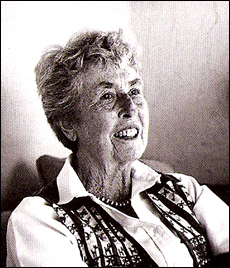Santa Fe Living Treasures – Elder Stories
<<Back to Treasures Index
Sallie WagnerGUARDIAN OF CULTURAL HERITAGEHonored November, 1990 | Sallie WagnerThere are no howling coyotes in Sallie Wagner's home. Instead, there are boxes full of nacimientos (nativities) from the pueblos and the Spanish villages, and a Japanese door curtain over the door depicting animals coming to the Buddha. "The art of the craftsman is a bond between the peoples of the world,' says a sign above the Folk Art Museum," said Sallie, who has collected and marketed Native American and folk art throughout her life. Born in 1913 to Dwight and Elsie Wagner in "West, by God, Virginia," Sallie grew up with a brother and sister in Wheeling. "We had quite a bit of property. My brother kept finding arrowheads and grinding stones all over the property," she said. When he got tired of his collection, he gave it to Sallie. "I became interested in Indians through that. One Sunday afternoon I was reading the travel section of the New York Times, and I read all about New Mexico--about the Indians out here. I talked my father into bringing me out; that was in 1928," said Sallie. "I kept coming back." Dwight Wagner was in the steel business. "The company owned a lot of flat land along the Ohio River" on which they planned to build mills, Sallie said. "There were a lot of mounds on that land. I persuaded my father to have the company sponsor a dig on one of the mounds, and the Pennsylvania Museum did a dig one summer. I think I was about fourteen years old, but they let me dig anyway," and the anthropologists suggested to Sallie that she consider attending the University of Chicago. After completing boarding school in Washington, D.C., Sallie went to Chicago and began her studies. She returned to Santa Fe during the summers. Sallie met William Lippincott at college. "He got a job with the National Park Service. We got married in 1936," she said. While working at Canyon de Chelly, William decided to leave government employment. The couple bought Wide Ruins Trading Post in 1938. "Wide Ruins was seventeen miles north of Chambers," Arizona, said Sallie. "The nearest town was Gallup and it was seventy miles away." Wide Ruins was a general store, and William and Sallie sold "everything from wagons to lollipops," she said. "I don't think there are any trading posts anymore. It's all based on a cash economy now." Sallie and her husband were in the trading post business for thirteen years, and during that time she persuaded Navajo rug makers to use vegetable dyes. Please see Volume 1 for complete text. |

